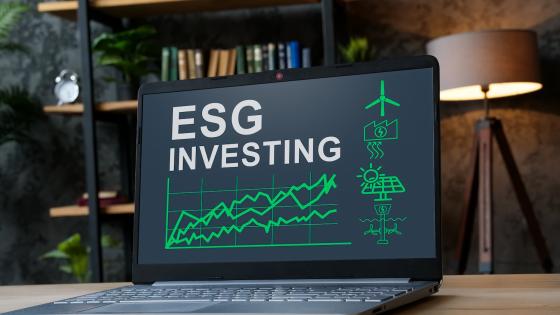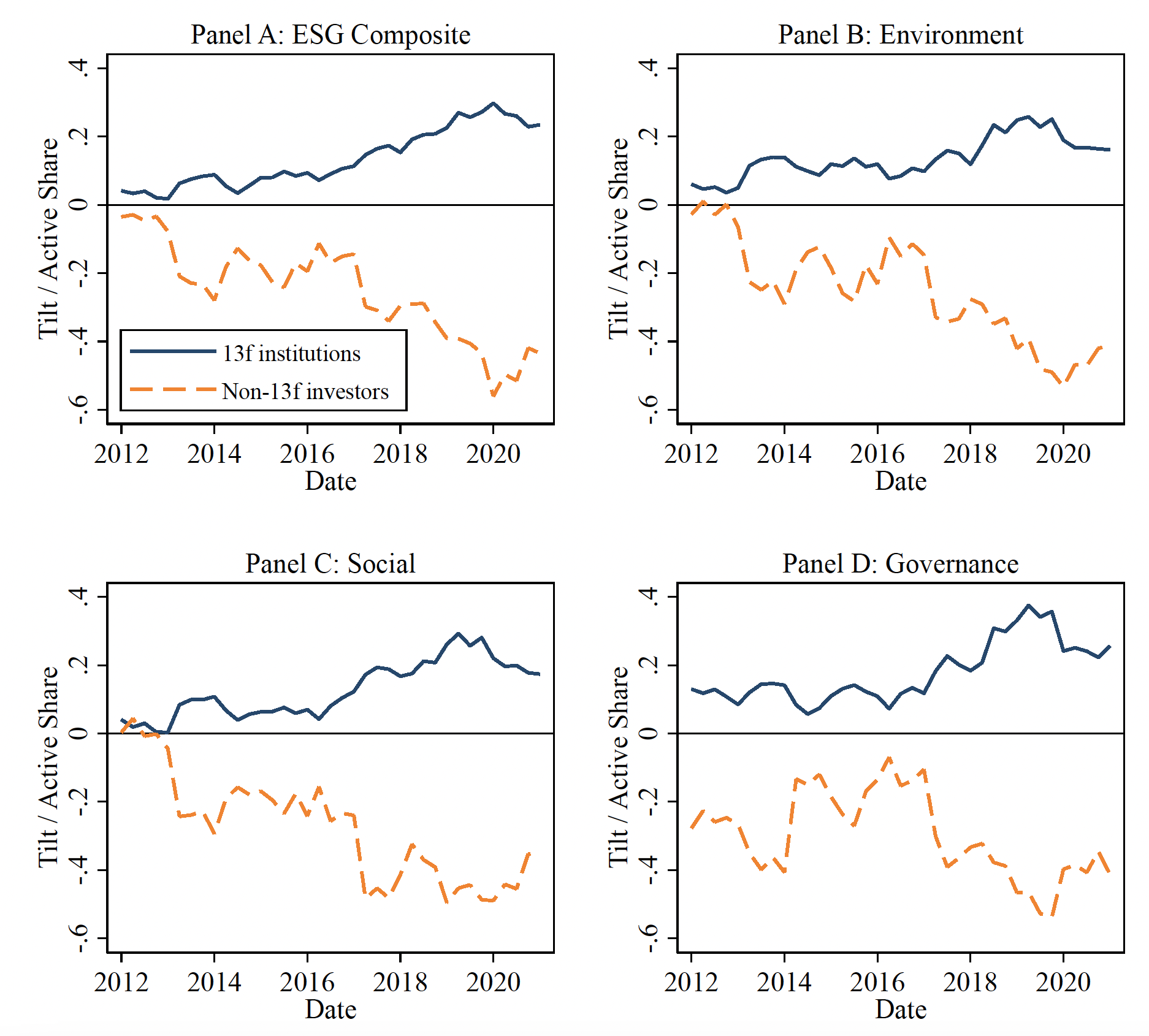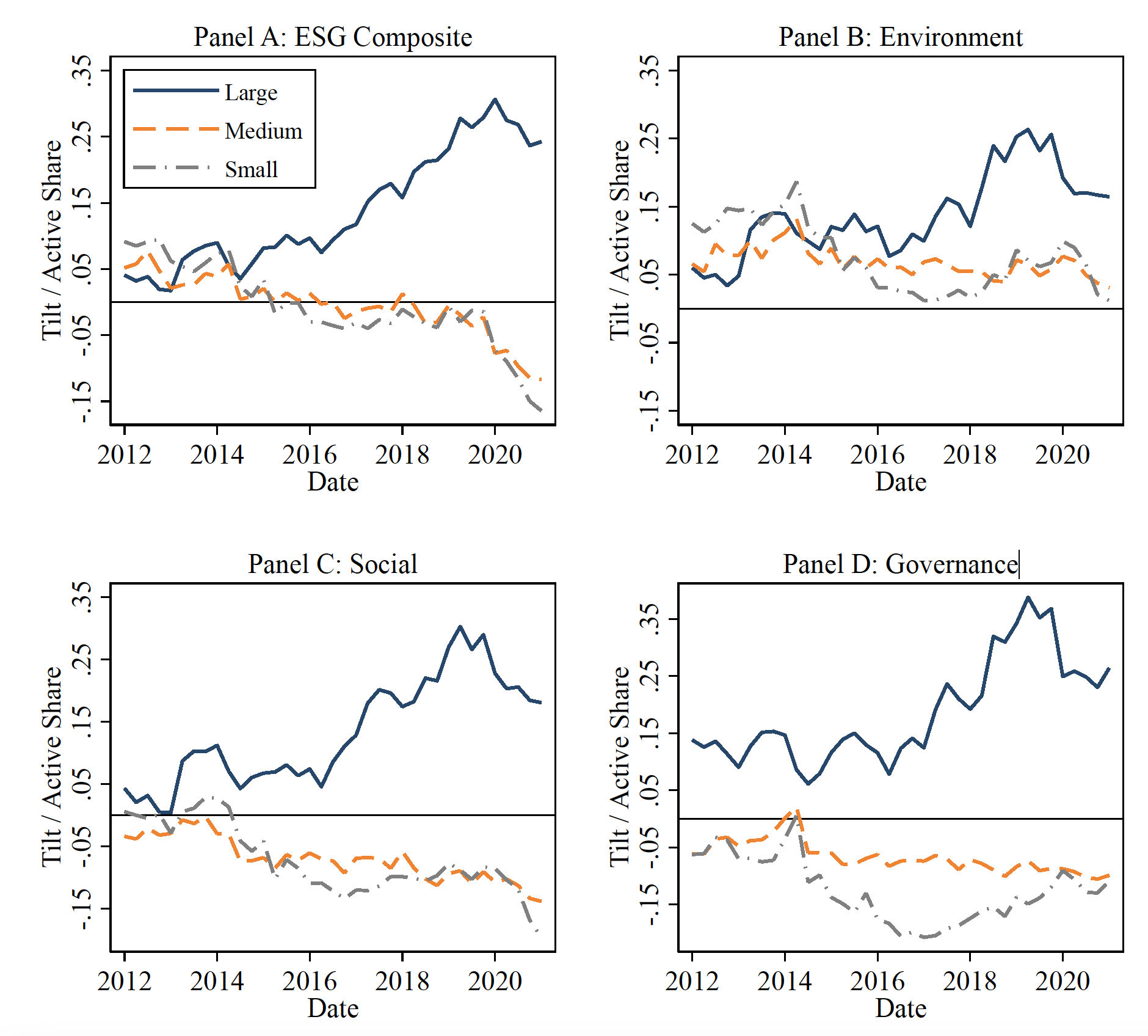Achieving the United Nations’ Sustainable Development Goals and Paris climate goals will require a large amount of capital (Volz and Schoenmaker 2022). Some of this capital could potentially be provided by investors using environmental, social, and governance (ESG) criteria. To assess the potential of ESG investing to contribute to policy goals, it seems useful for policymakers to know how much capital is invested according to ESG principles.
ESG investing has clearly exploded in popularity, but its total amount is unclear. For example, according to Bloomberg Intelligence, global ESG assets under management (AUM) surpassed $35 trillion in 2020 (Bloomberg 2022). According to PwC (2022), global ESG assets under management amounted to $18 trillion as of 2021. Perhaps the most-cited figure is $121 trillion, which is the total assets under management of the signatories of the United Nations Principles for Responsible Investment (UN PRI) as of March 2022 (UNPRI 2022). These numbers are vastly different from each other.
Adding up the assets under management of institutions that include ESG in their stated investment policies is simple and transparent. However, it could overstate or understate the total amount of ESG-related investing. Some institutions might engage in greenwashing, while others might use ESG characteristics in their investing without declaring an ESG policy.
How much ESG investing is there, really?
In our paper (Pastor et al. 2023), we quantify ESG-related investing by estimating ESG-related portions of institutions’ equity portfolio weights. We take companies’ environmental, social, and governance characteristics from ratings provided by MSCI, a leading provider. For each institution that has filed the 13F form to the Securities and Exchange Commission (SEC), we estimate how every stock’s ESG characteristics relate to the stock’s weight in the institution’s portfolio. Combining these estimates across stocks gives an institution-level measure of ESG-related tilt. We aggregate those tilts across institutions to estimate the total ESG-related portfolio tilt in the investment industry.
We find that the total dollar ESG-related tilt is about 6% of the investment industry’s assets under management in equity investments in 2021. By this measure, there is much less ESG investing than commonly reported. For example, the UN PRI signatories account for 76% of our sample’s assets under management. The 6% number is close to the magnitude of the aggregate ESG tilt throughout our 2012-2021 sample, as we show in Figure 1.
Figure 1 ESG-related tilts
Notes: The figure plots the aggregate ESG-related tilt (T) and its intensive- and extensive-tilts components. Tilts are expressed as a fraction of institutions' aggregate assets under management.
When computing ESG-related tilts, we consider both the extensive margin (i.e. which stocks are held) and the intensive margin (i.e. weights on stocks held). We find significant ESG effects at both margins, but the intensive-margin effects are two to three times larger (see Figure 1).
When estimating ESG tilts, we control for the stock’s non-ESG characteristics such as size and book-to-market, which are known to be correlated with ESG characteristics. For example, an institution may hold Tesla’s stock because it views Tesla as environmentally friendly or because it likes holding large-cap growth stocks. Our approach separates the two motives.
We allow a stock’s environmental, social, and governance characteristics to enter separately, recognising, for example, that investors may assess Tesla’s environmental virtues separately from Tesla’s treatment of its employees. We find each of those three dimensions contributes about equally to aggregate ESG-related tilts. We also find that using only a composite ESG score misses over 40% of the tilts associated with the environmental, social, and governance characteristics.
The investment industry is increasingly green
We measure the extent to which ESG tilts are green or brown. We compute each institution’s net tilt toward green stocks, or ‘GMB’ tilt (green minus brown). Aggregating GMB tilts across all 13F institutions gives the industry’s GMB tilt. We find that the investment industry is increasingly green, exhibiting a consistently positive and rising GMB tilt since 2012. This result holds for any of four dimensions of greenness (composite ESG, E, S, and G), as we show in Figure 2.
Figure 2 Green-minus-brown tilts of 13F filers and non-filers
Notes: The solid line shows the assets under management-weighted average of tilt divided by active share across sample 13F institutions. The dashed line shows the same quantity for non-13F investors. The four panels correspond to four different measures of greenness (the composite ESG score, E, S, and G).
In contrast, the aggregate portfolio of non-13F investors has become browner. Prior evidence on ESG-related trading by retail investors is mixed (e.g. Choi et al. 2020, Li et al. 2023, and Moss et al. 2021). Focusing on ESG-related portfolio tilts, we find that the portfolios of non-13F investors, most of whom are retail investors, tilt brown, and increasingly so (see Figure 2).
The rise in the green-minus-brown tilt of 13F-filing institutions occurs primarily via the intensive margin, i.e. increasingly overweighting green stocks and underweighting brown stocks. For example, divestment from brown stocks, a long-standing theme, occurs largely at the intensive margin, meaning that most of this divestment involves reducing positions rather than eliminating them.
Largest institutions are greenest, increasingly so
The industry’s increasing greenness is driven by the largest institutions. When we rank institutions by assets under management and separate them at the 33rd and 66th percentiles, we find that only the top third exhibits a positive and rising green-minus-brown tilt. The green-minus-brown tilts of the middle and bottom thirds are mostly negative and decreasing over time. This is shown in Figure 3.
Figure 3 Institution size and greenness
Notes: This figure compares green-minus-brown (GMB) tilts across subsamples formed on institution size. Large, medium, and small institutions are those with assets under management in the top, middle, and bottom quarterly tercile, respectively. Each line shows the assets under management-weighted average of GMB tilt divided by active share within a subsample of institutions. The four panels correspond to four different measures of greenness (the composite ESG score, E, S, and G).
Existing studies find mixed evidence on whether UN PRI signatories engage in ESG-related behaviour, raising concerns about greenwashing (Gibson et al. 2022, Liang et al. 2022, Kim and Yoon 2023). In contrast, we find that institutions that have signed the UN PRI are significantly greener, in that they have larger green-minus-brown tilts. This result holds not only across institutions but also over time, indicating that a given institution becomes greener after becoming a signatory. We also find that the least green institution type is banks.
Conclusion
The total amount of ESG-related tilts in institutional equity portfolios is substantial, about 6% of the institutions’ total equity assets under management, but much smaller than the aggregate assets under management of institutions that proclaim to follow ESG-related principles. The intensive margin tilts are two to three times larger than the extensive-margin ones. Institutions as a whole tilt more green than brown, and increasingly so. This pattern is driven by the largest institutions. In contrast, small institutions, non-13F institutions, and households tilt more brown than green, and increasingly so.
We are currently extending this work in several directions. To complement our results on aggregate and institution-level tilts, we are exploring stock-level tilts. We are comparing US and non-US institutions, and also looking at how institutions vote on shareholder proposals. We are adding a theoretical model. There is much to be done in this fascinating research agenda.
References
Bloomberg (2022), “ESG may surpass $41 trillion assets in 2022, but not without challenges”, Press relase, 24 January.
Choi, D, Z Gao and W Jiang (2020), “Attention to global warming”, Review of Financial Studies 33: 1112-1145.
Gibson Brandon, R, S Glossner, P Krueger, P Matos and T Steffen (2022), “Do responsible investors invest responsibly?”, Review of Finance 26: 1389-1432.
Kim, S and A Yoon (2023), “Analyzing active fund managers’ commitment to ESG: Evidence from the United Nations Principles for Responsible Investment”, Management Science 69: 741-758.
Li, Q, E M Watts and C Zhu (2023), “Retail investors and ESG news”, Working paper.
Liang, H, L Sun and M Teo (2022), “Responsible hedge funds”, Review of Finance 26: 1585-1633.
Moss, A, J P Naughton and C Wang (2020), “The irrelevance of ESG disclosure to retail investors: Evidence from Robinhood”, Working paper.
Pastor, L, R Stambaugh and L Taylor (2023), “Green tilts”, NBER Working Paper 31320.
Pwc (2022), Asset and wealth management revolution 2022: Exponential expectations for ESG.
UNPRI - United Nations Principles for Responsible Investment (2022), Annual Report 2021-2022.
Volz, U and D Schoenmaker (2022), “Scaling up sustainable finance and investment in the Global South”, VoxEU.org, 1 November.








